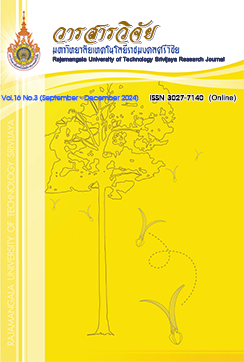Lateritic Soil Quality Improvement Using Palm Oil Fuel Ash and Cement for Road Construction
Keywords:
Namom lateritic soil, palm oil fuel ash, Portland cement type 1, road construction, compressive strength, scanning electron microscopeAbstract
This research studied the possibility of using Palm Oil Fuel Ash (POFA) and Portland cement Type 1 to improve the quality of lateritic soil from the Ban Khuan Chong, Namom district, Songkhla province for road construction. The soil was improved by incorporating cement at proportions of 2%, 3%, 4%, and 5% by weight, and by incorporating a mixture of POFA with particle sizes less than 45 microns at proportions of 5%, 10%, and 15% by weight, along with 5% cement. The preliminary and engineering properties of the soil were tested, including chemical composition analysis (XRF) and microstructure analysis using a scanning electron microscope (SEM). The study found that the main components of the laterite soil improved with POFA and cement were SiO2, Al2O3, Fe2O3, CaO and K2O. The soil improved with cement achieved a maximum compressive strength of 24.8 ksc at 5% cement content over a curing period of 28 days. The soil improved with POFA and cement showed an increase in optimum moisture content (OMC) from 9.7% to 11.2%, resulting in a decrease in maximum dry density (MDD) from 1.970 to 1.861 g/cm3. The soil also achieved the maximum compressive strength of 31.1 ksc at a 5% cement mixed with 5% POFA over a curing period of 28 days. The compressive strength decreased with an increase in the amount of POFA. The soil samples improved with cement at all proportions and the soil samples improved with 5% cement and 5% POFA over a curing period of 7 days met the subbase layer requirements for soil-cement subbase according to the Department of Highways standards for road construction. over a curing period of 7 days met the subbase layer requirements for soil-cement subbase according to the Department of Highways standards for road construction.
References
Ahmad, J., Rahman, A.S.A., Ali, M.R.M. and Rahman, K.F.A. 2011. Peat soil treatment using POFA, pp. 66-70. In IEEE Colloquium on Humanities, Science and Engineering Research. Penang, Malaysia.
Alexander, L.T. and Cady, J.G. 1962. Genesis and hardening of laterite in soils. Soil Science 96(1): 7-8.
ASTM. 2019. ASTM C618-19 Standard Specification for Coal Fly Ash and Raw or Calcined Natural Pozzolan for Use in concrete. American Society for Testing and Materials, West Conshohocken, PA, USA.
DOH. 1972a. Abrasion test Standard (DH-T 202/2515). Department of Highways, Ministry of Transport, Bangkok. (in Thai)
DOH. 1972b. Atterberg limits test standard (DH-T 102/2515 and 103/2515). Department of Highways, Ministry of Transport, Bangkok. (in Thai)
DOH. 1972c. Unconfined compressive strength test standard (DH-T 105/2515). Department of Highways, Ministry of Transport, Bangkok. (in Thai)
DOH. 1974a. Sieve analysis test standard (DH-T 205/2517). Department of Highways, Ministry of Transport, Bangkok. (in Thai)
DOH. 1974b. Modified proctor test standard (DH-T 108/2517). Department of Highways, Ministry of Transport, Bangkok. (in Thai)
DOH. 1974c. California bearing ratio test standard (DH-T 109/2517). Department of Highways, Ministry of Transport, Bangkok. (in Thai)
DOH. 1989. Soil aggregate subbase standard for road construction (DH-S 205/2532). Department of Highways, Ministry of Transport, Bangkok. (in Thai)
DOH. 2021. Soil - cement subbase standard for road construction (DH-S 206/2564). Department of Highways, Ministry of Transport, Bangkok. (in Thai)
Ivanic, M., Vdovic, N., Barreto, S.D.B., Bermanec, V. and Sondi, I. 2015. Mineralogy, surface properties and electrokinetic behavior of kaolin clays from the naturally occurring pegmatite deposits. Geologia Croatica 68(2): 139-145.
Jaturapitakkul, C. 2012. Biomass ash from industry: Problems, Limitations and Applications. Concrete Journal TCA e-magazine 17: 14-23. (in Thai)
Land Development Department. 2020. Management of laterite soil. LDD E-library. Available Source: http://library. ldd.go.th, February 16, 2020. (in Thai)
Ministry of Transport Operation Center. 2021. Road infrastructure. Road infrastructure. Available Source: https:// motoc.mot.go.th/infras, March 6, 2023. (in Thai)
Nnochiri, E.S., Ogundipe, O.M. and Oluwatuyi, O.E. 2017. Effects of palm kernel shell ash on lime-stabilized lateritic soil. Slovak Journal of Civil Engineering 25(3): 1-7.
Office of Agricultural Economics. 2020. Information on the production of agricultural products. Palm oil product details. Available Source: https://www. oae.go.th, March 6, 2023. (in Thai)
Oke, J. and Kolawole, O. 2020. Effects of Compactive Effort on Laterite -Oil Palm Empty Fruit Bunch Ash Mixture. Covenant Journal of Engineering Technology 4(1): 30-48.
Onyelowe, K.C. 2019. Nanosized palm bunch ash (NPBA) stabilization of lateritic soil for construction purposes. International Journal of Geotechnical Engineering 13(1): 83-91.
Otunyo, A.W. and Chukuigwe, C.C. 2018. Investigation of the impact of palm bunch ash on the stabilization of poor lateritic soil. Nigerian Journal of Technology 37(3): 600-604.
Phudphong, W. and Hormdee, D. 2022. Utilization of geopolymer on improvement of loess soil using palm oil fuel ash and granulated blast furnace slag. Engineering Journal of Research and Development 33(1): 49-59.
Pourakbar, S., Asadi, A., Huat, B.B.K. and Fasihnikoutalab, M.H. 2015. Soil stabilization with alkali-activated agro-waste. ICE Environmental Geotechnics 2(6): 359-370.
Rakson, S., Chaturapitakkul, C., Chucheepsakul, S. and Chindaprasert, P. 2005. Use of palm oil fuel ash in concrete. Engineering Research and development Journal 16(2): 38-43. (in Thai)
Downloads
Published
How to Cite
Issue
Section
License
Copyright (c) 2024 Rajamangala University of Technology Srivijaya Research Journal

This work is licensed under a Creative Commons Attribution-NonCommercial-NoDerivatives 4.0 International License.
The content and information in the article published in Journal of Rajamangala University of Technology Srivijaya It is the opinion and responsibility of the author of the article. The editorial journals do not need to agree. Or share any responsibility.







